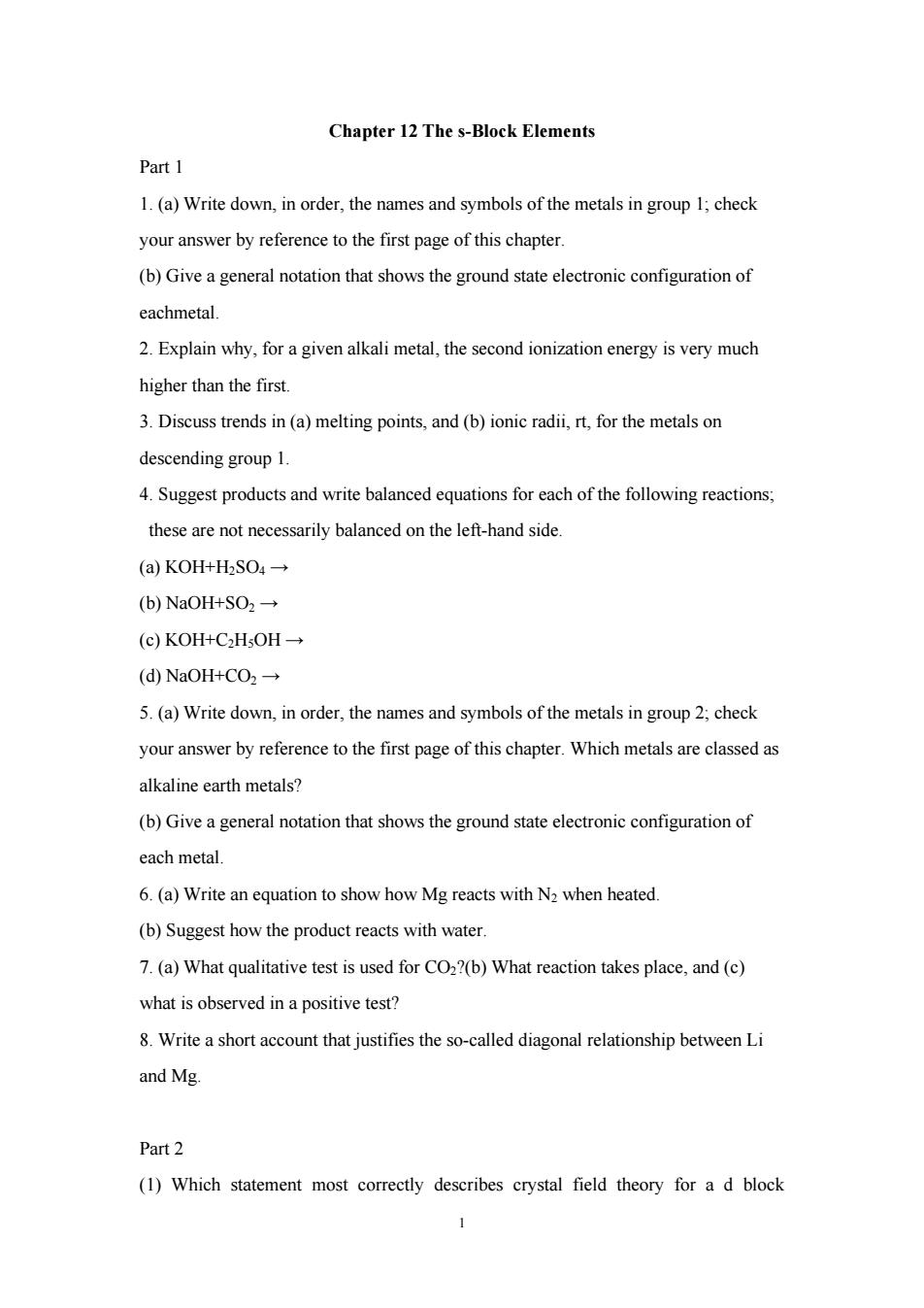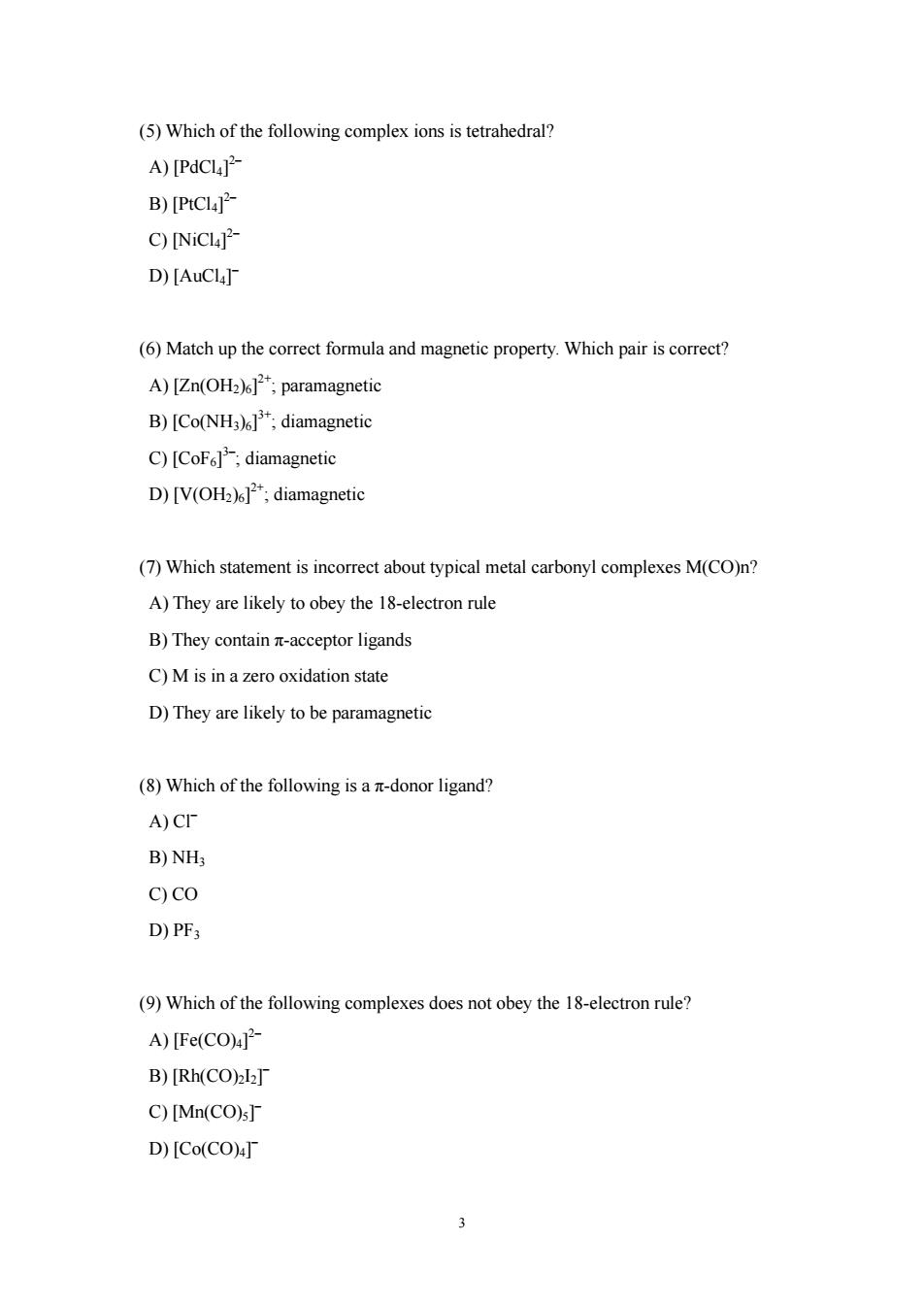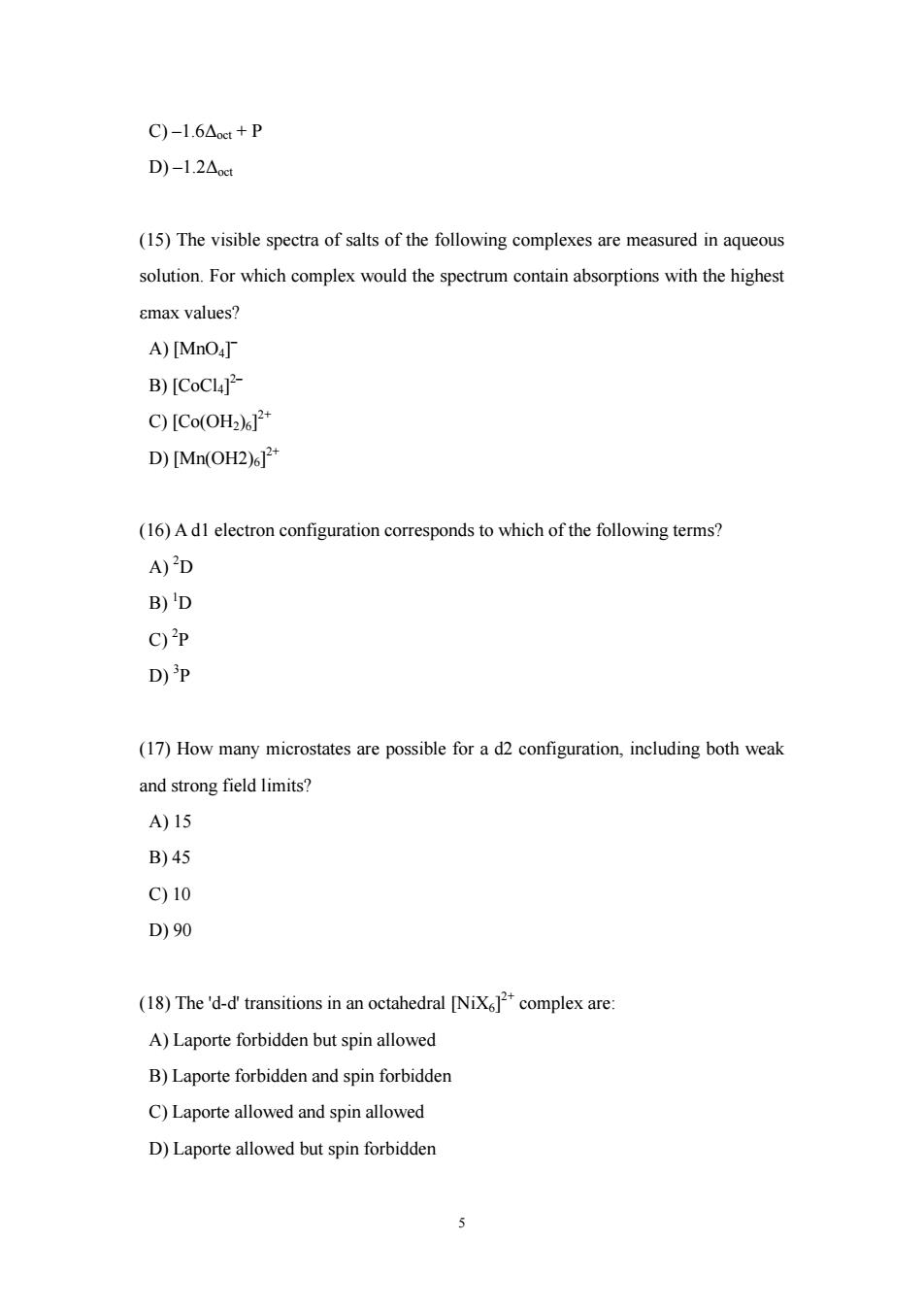
Chapter 12 The s-Block Elements Part1 1.(a)Write down,in order,the names and symbols of the metals in group check your answer by reference to the first page of this chapter (b)Give a general notation that shows the ground state electronic configuration of eachmetal. 2.Explain why,for a given alkali metal,the second ionization energy is very much higher than the first. 3.Discuss trends in(a)melting points,and(b)ionic radii,rt,for the metals on descending group 1. 4.Suggest products and write balanced equations for each of the following reactions these are not necessarily balanced on the left-hand side (a)KOH+H2SO.4→ (b)NaOH+SO2→ (c)KOH+C2HsOH- (d)NaOH+CO2→ 5.(a)Write down,in order,the names and symbols of the metals in group2:check your answer by reference to the first page of this chapter.Which metals are classed as alkaline earth metals? (b)Give a general notation that shows the ground state electronic configuration of each metal. 6.(a)Write an equation to show how Mg reacts with N2 when heated (b)Suggest how the product reacts with water. 7.(a)What qualitative test is used for CO2?(b)What reaction takes place,and(c) what is observed in a positive test? 8.Write a short account that justifies the so-called diagonal relationship between Li and Mg. Part2 (1)Which statement most correctly describes crystal field theory for a d block 1
Chapter 12 The s-Block Elements Part 1 1. (a) Write down, in order, the names and symbols of the metals in group 1; check your answer by reference to the first page of this chapter. (b) Give a general notation that shows the ground state electronic configuration of eachmetal. 2. Explain why, for a given alkali metal, the second ionization energy is very much higher than the first. 3. Discuss trends in (a) melting points, and (b) ionic radii, rt, for the metals on descending group 1. 4. Suggest products and write balanced equations for each of the following reactions; these are not necessarily balanced on the left-hand side. (a) KOH+H2SO4 → (b) NaOH+SO2 → (c) KOH+C2H5OH → (d) NaOH+CO2 → 5. (a) Write down, in order, the names and symbols of the metals in group 2; check your answer by reference to the first page of this chapter. Which metals are classed as alkaline earth metals? (b) Give a general notation that shows the ground state electronic configuration of each metal. 6. (a) Write an equation to show how Mg reacts with N2 when heated. (b) Suggest how the product reacts with water. 7. (a) What qualitative test is used for CO2?(b) What reaction takes place, and (c) what is observed in a positive test? 8. Write a short account that justifies the so-called diagonal relationship between Li and Mg. Part 2 (1) Which statement most correctly describes crystal field theory for a d block 1

complex of unspecified geometry? A)The theory considers covalent interactions between a metal centre and the surrounding ligands B)The theory considers electrostatic interactions between a metal ion and the surrounding ligands which are taken to be point charges C)The theory rationalizes the non-degeneracy of the metal d orbitals by considering the electrostatic repulsions between point charge ligands and electrons in the metald orbitals D)The theory rationalizes why the metal d orbitals are split into two levels (2)Which of the following correctly places the ligands in their order in the spectrochemical series? A)Br-<Cl-<NH3<H20 B)-<Br-<H20<[OH C)F-<CI-<H20<NH3 D)I-<Cl-<H2O<en (3)Which of the following correctly places the metal centres in their order in the spectrochemical series? A)Mn(II)<Fe(III)<Rh(III) B)Cc(I)<Co(D<Rh(四 C)Pt(IV)<Pd(II)<Ni(II) D)Pd(ID)<Ni(ID)<Pt(IV) (4)Which metal complex ion is expected to be subject to a Jahn-Teller distortion? [Cr(OH2)] B)[Cr(NH3)6 C)[Cr(CN)] D)[Cr(bpy)
complex of unspecified geometry? A) The theory considers covalent interactions between a metal centre and the surrounding ligands B) The theory considers electrostatic interactions between a metal ion and the surrounding ligands which are taken to be point charges C) The theory rationalizes the non-degeneracy of the metal d orbitals by considering the electrostatic repulsions between point charge ligands and electrons in the metal d orbitals D) The theory rationalizes why the metal d orbitals are split into two levels (2) Which of the following correctly places the ligands in their order in the spectrochemical series? A) Br– < Cl– < NH3 < H2O B) I– < Br– < H2O < [OH]– C) F– < Cl– < H2O < NH3 D) I– < Cl– < H2O < en (3) Which of the following correctly places the metal centres in their order in the spectrochemical series? A) Mn(II) < Fe(III) < Rh(III) B) Co(III) < Co(II) < Rh(III) C) Pt(IV) < Pd(II) < Ni(II) D) Pd(II) < Ni(II) < Pt(IV) (4) Which metal complex ion is expected to be subject to a Jahn-Teller distortion? ) [Cr(OH2)6] 3+ B) [Cr(NH3)6] 2+ C) [Cr(CN)6] 3– D) [Cr(bpy)3] 2+ 2

(5)Which of the following complex ions is tetrahedral? A)[PdCL]- B)[PtCla- C)[NiCl]- D)[AuCl4] (6)Match up the correct formula and magnetic property.Which pair is correct? A)[Zn(OH2)];paramagnetic B)[Co(NH3)];diamagnetic C)[CoF]diamagnetic D)[V(OH2)diamagnetic (7)Which statement is incorrect about typical metal carbonyl complexes M(CO)n? A)They are likely to obey the 18-electron rule B)They contain -acceptor ligands C)M is in a zero oxidation state D)They are likely to be paramagnetic (8)Which of the following is a -donor ligand? A)cr B)NH c)co D)PF3 (9)Which of the following complexes does not obey the 18-electron rule? A)[Fe(CO)4 B)[Rh(CO)2I2 C)[Mn(CO)s D)[Co(CO)4
(5) Which of the following complex ions is tetrahedral? A) [PdCl4] 2– B) [PtCl4] 2– C) [NiCl4] 2– D) [AuCl4] – (6) Match up the correct formula and magnetic property. Which pair is correct? A) [Zn(OH2)6] 2+; paramagnetic B) [Co(NH3)6] 3+; diamagnetic C) [CoF6] 3–; diamagnetic D) [V(OH2)6] 2+; diamagnetic (7) Which statement is incorrect about typical metal carbonyl complexes M(CO)n? A) They are likely to obey the 18-electron rule B) They contain π-acceptor ligands C) M is in a zero oxidation state D) They are likely to be paramagnetic (8) Which of the following is a π-donor ligand? A) Cl– B) NH3 C) CO D) PF3 (9) Which of the following complexes does not obey the 18-electron rule? A) [Fe(CO)4] 2– B) [Rh(CO)2I2] – C) [Mn(CO)5] – D) [Co(CO)4] – 3

(10)Which of the following statements is incorrect? A)The electronic spectrum of [Ni(NH3)6 contains 3 absorptions B)Absorptions in the electronic spectrum of [Mn(extremely weak C)For a tetrahedral d4 complex.3 absorptions are expected in its electronic spectrum D)The absorption in the electronic spectrum of [Ti(His assigned to the E T2gtransition (11)[Cr(CN)6]is expected to be: A)paramagnetic with e≈3.87μB B)diamagnetic C)paramagnetic with Her<3.87uB D)paramagnetic with He>3.87 uB (12)Which series correctly places the ligands in order of increasing nephelauxetic effect? A)F<Cr<r B)r<Cr<F C)en<NH3<H2O D)I<Br<[CN] (13)For which pair of complexes is the order of values of Aoct correct? A)[Rh(NH3)>[Co(NH) B)[Fe(CN)>[Fe(CN)] C)[Cr(OH2)>[Cr(OH2)] D)[CrFs]>[Cr(CN)] (14)The CFSE for a high-spin d4 octahedral complex is: A)-0.6At B)-1.8Ac
(10) Which of the following statements is incorrect? A) The electronic spectrum of [Ni(NH3)6] 2+ contains 3 absorptions B) Absorptions in the electronic spectrum of [Mn(OH2)6] 2+ are extremely weak C) For a tetrahedral d4 complex, 3 absorptions are expected in its electronic spectrum D) The absorption in the electronic spectrum of [Ti(OH2)6] 3+ is assigned to the Eg ← T2g transition (11) [Cr(CN)6] 3– is expected to be: A) paramagnetic with μeff ≈ 3.87 μB B) diamagnetic C) paramagnetic with μeff < 3.87 μB D) paramagnetic with μeff > 3.87 μB (12) Which series correctly places the ligands in order of increasing nephelauxetic effect? A) F- < Cl– < I– B) I– < Cl– < F– C) en < NH3 < H2O D) I– < Br– < [CN]– (13) For which pair of complexes is the order of values of Δoct correct? A) [Rh(NH3)6] 3+ > [Co(NH3)6] 3+ B) [Fe(CN)6] 4– > [Fe(CN)6] 3– C) [Cr(OH2)6] 2+ > [Cr(OH2)6] 3+ D) [CrF6] 3– > [Cr(CN)6] 3– (14) The CFSE for a high-spin d4 octahedral complex is: A) –0.6Δoct B) –1.8Δoct 4

C)-1.6Aoct+P D)-1.2△i (15)The visible spectra of salts of the following complexes are measured in aqueous solution.For which complex would the spectrum contain absorptions with the highest emax values? A)[MnO4 B)[CoCL]2- C)[Co(OH2) D)[Mn(OH2)612* (16)Adl electron configuration corresponds to which of the following terms? A)D B)'D C)P D)P (17)How many microstates are possible for a d2 configuration,including both weak and strong field limits? A)15 B)45 C)10 D)90 (18)The'd-d'transitions in an octahedral [NiXcomplex are: A)Laporte forbidden but spin allowed B)Laporte forbidden and spin forbidden C)Laporte allowed and spin allowed D)Laporte allowed but spin forbidden
C) –1.6Δoct + P D) –1.2Δoct (15) The visible spectra of salts of the following complexes are measured in aqueous solution. For which complex would the spectrum contain absorptions with the highest εmax values? A) [MnO4] – B) [CoCl4] 2– C) [Co(OH2)6] 2+ D) [Mn(OH2)6] 2+ (16) A d1 electron configuration corresponds to which of the following terms? A) 2 D B) 1 D C) 2 P D) 3 P (17) How many microstates are possible for a d2 configuration, including both weak and strong field limits? A) 15 B) 45 C) 10 D) 90 (18) The 'd-d' transitions in an octahedral [NiX6] 2+ complex are: A) Laporte forbidden but spin allowed B) Laporte forbidden and spin forbidden C) Laporte allowed and spin allowed D) Laporte allowed but spin forbidden 5